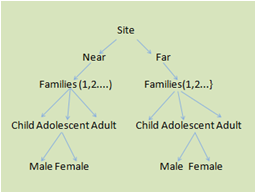|
Data management Recording of family data was more difficult to manage. Separate recording
sheets were prepared for each family as illustrated here.
Recorded infection data are discrete (+ve or −ve) and likely to be analysed by a method for dealing with counts or proportions such as logistic regression. It is therefore important to establish an appropriate observational unit for the analysis. It helps to consider how the data are structured. The study takes the form of a cluster. Five sites were initially identified, then two locations within each site (near and far from the river) and then four families within each location. Within each family three age categories were defined and each individual was also classified by his/her gender. Each individual was then sampled once a month. |

 Before any data recording begins it is important to decide how the collected data will be analysed.
Consider Objective 3: to determine whether the prevalence of schistosomiasis in humans varies with age
or gender and with the distance of the family from the river.
Before any data recording begins it is important to decide how the collected data will be analysed.
Consider Objective 3: to determine whether the prevalence of schistosomiasis in humans varies with age
or gender and with the distance of the family from the river.